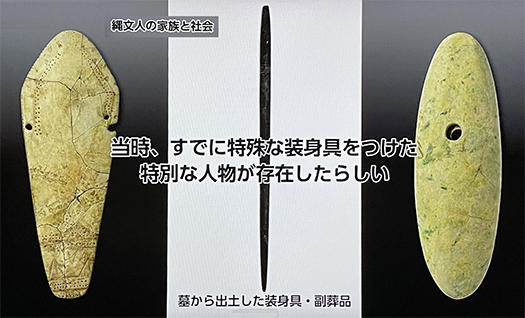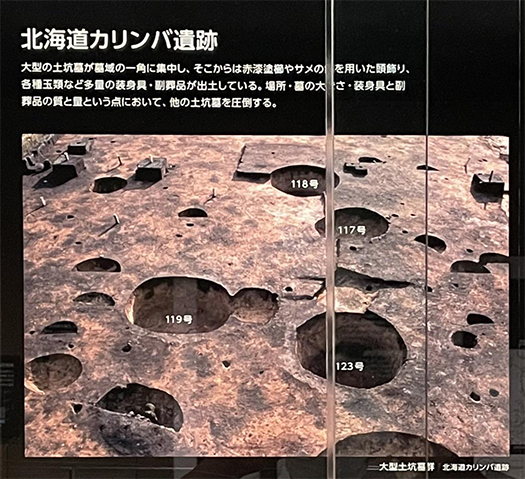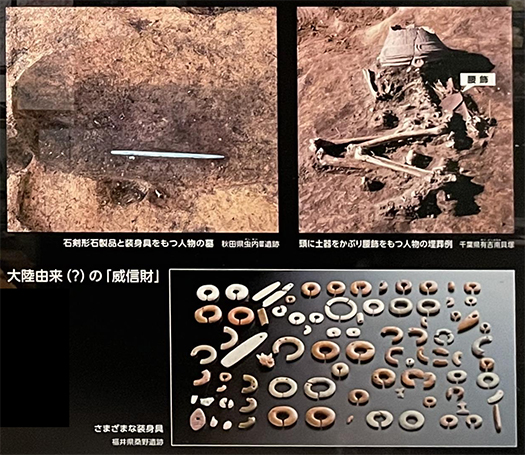


きのうは土偶の女性神表現、アマテラスの祖型とのアナロジーを書いた。
それは人間の基本である「生」生む力についてだったけれど、
人間は生まれれば必ず死ぬ。どんな精神性で死を人間社会は受容したのか。
縄文の世が示したその実相とそこから見える「格差」について。
あらゆる社会の祭祀の基本には人間の死という巨大テーマがある。
社会が発展すればするほどにその進化力の基本である
「人間力」への依存があるのだと思う。
とくに定住が始まって以降、人間の寿命が伸びたことは自明。
狩猟が基本的な食料獲得手段であった旧石器時代には
体力的運動能力が人間の寿命と密接な関係だっただろうけれど、
そのような体力勝負だけではない食糧生産方法が獲得されて
「経験知」というものの社会的役割が飛躍的に向上したことは間違いない。
どこに行けばどういう食糧を獲得できるという経験知の総和は
そのムラ社会にとってかけがえのない情報であり共有されるべきだった。
そうした「公知」領域が拡大して行くにつれて
情報を蓄積保存する「長〜おさ」のような存在が決定的になった。
社会が維持発展していくのにこのことは不可欠だっただろう。
こうした社会の要請の結果、特定個人、その「家系」が
いわば「特別な地位」を得ていくことは自然に起こったことだろう。


〜「特別な人びとの出現」石棒やヒスイ製装身具などの遺物が出土する墓は
上位階層の墓と理解されてきている。社会の階層化の見える化。〜
〜「縄文人の一生」●50歳くらい。集落を仕切るリーダーとなりムラ間の交渉、
調整を行い若年層を指導する。このような「特別な人」は東日本では男性が多く
西日本では女性が多かった。〜国立歴史民俗博物館展示パネルより。
縄文社会にとって決定的だった人間力を持った個人に対して
その死に対して「格別のカタチ」が取られていくのは自然。
葬られるときにその特別性に対して威信材が合祀されたり
墓の規模において「特別性」が発揮されていったのも当然の成り行き。
マルクス・エンゲルス当時の考古学段階では「原始共産社会」と思えたものが
実際はそういう理解の方が非科学的だと解明されてきている。
男性DNAの皆殺しという、全殺戮が一般的な大陸社会の先史遺跡とは違って
遺跡痕跡の連続性の高い日本列島という地域としては
こういう人類通史的観点が可能ともいえると思っている。
そしてこうした「社会共有の公知」という事柄が重層していって
それらを抽象する「祭政」という形而上的な事象が起こったのだろう。
日本語で「まつりごと」というコトバにはこの2つの意味合いが込められる。
いわば社会の意思決定についての2側面を表している。
より大きな概念としては「祭祀」ということであって
政治とは日常的な意思決定の権能を表現しているのだろう。
後の世の卑弥呼と、政治権力者との姉弟関係にも象徴されるのだろうか。
English version⬇
Death and Mourning: The Reality of the Jomon Disparity in Society 37,000 Years of the Japanese Archipelago – 20
It is becoming “visible” that the “festival” symbolized by the sister-brother relationship between Himiko and the political powers has its origins in the Jomon. …
Yesterday, I wrote about the female deity representation of clay figurines and its analogy to the ancestral form of Amaterasu.
It was about the power of birth, which is the basis of human beings.
When human beings are born, they must die. With what kind of mentality did human society accept death?
The Jomon period showed us the reality and the “disparity” that can be seen from it.
The huge theme of human death is the basis of the rituals of all societies.
The more a society develops, the more it relies on “human power,” which is the basis of its evolutionary power.
The more a society develops, the more it relies on “human power,” which is the basis of its evolutionary power.
It is obvious that human life expectancy has increased, especially since the beginning of settlement.
In the Paleolithic Era, when hunting was the basic means of obtaining food
physical exercise capacity would have been closely related to human life span.
However, as methods of food production that did not rely solely on physical strength were acquired, the role of “experiential knowledge” in society became increasingly important.
There is no doubt that the role of “experiential knowledge” in society has dramatically improved.
The sum total of experiential knowledge of where to go and what kind of food to obtain is
The sum total of experiential knowledge about where to go and what kind of food to obtain was invaluable information for the village society, and should have been shared.
As the area of such “public knowledge” expanded
As the area of such “public knowledge” expanded, the existence of a kind of “Naga~osah” that stores and preserves information became crucial.
This was essential for the maintenance and development of society.
As a result of these social requirements, certain individuals and their “family lineage” were given a “special status,” so to speak.
It was a natural consequence of these social needs that certain individuals and their “family lineage” gained “special status,” so to speak.
〜The tombs in which artifacts such as stone poles and jade jewelry have been excavated have been understood to be those of the higher hierarchies.
understood to be the tombs of the upper hierarchy. Visualization of social stratification. ~ “The Life of the Jomon People
〜The life of a Jomon man” – Around the age of 50. They are the leaders of the village, and they negotiate and coordinate among the villagers.
He is the leader of the village, negotiates and coordinates between villages, and guides the younger generation. Such “special people” were mostly male in eastern Japan and female in western Japan.
In western Japan, most of these “special people” were women. 〜From an exhibition panel at the National Museum of Japanese History.
For individuals who possessed human power, which was decisive for Jomon society
It is natural that a “special form” is taken for their death.
When buried, the prestige material is enshrined for its specialness.
It is also natural that “specialness” was demonstrated in the scale of the grave.
What seemed to be a “primitive communist society” in the archaeological phase at the time of Marx and Engels was in fact a “primitive communist society.
In fact, it is becoming clear that such an understanding is unscientific.
Unlike the prehistoric remains of continental societies, where the killing of all male DNA is common.
Unlike the prehistoric remains of continental societies, where the killing of all male DNA is common.
I believe that this kind of human historical perspective is possible in the Japanese archipelago, a region with a high degree of continuity in the traces of archaeological sites.
And, as these matters of “public knowledge shared by the society” are layered
This is the reason why the metaphysical phenomenon of “matsuri seiji,” which is an abstraction of such “public knowledge shared by society,” occurred.
The word “matsurigoto” in Japanese has both of these meanings.
It represents two aspects of social decision-making, so to speak.
The larger concept is that of “ritual.
Politics may express the authority of everyday decision-making.
Is it also symbolized in the relationship between Himiko in the later period and her sister and brother with political authority?
Posted on 11月 20th, 2022 by 三木 奎吾
Filed under: 日本社会・文化研究, 歴史探訪







コメントを投稿
「※誹謗中傷や、悪意のある書き込み、営利目的などのコメントを防ぐために、投稿された全てのコメントは一時的に保留されますのでご了承ください。」
You must be logged in to post a comment.